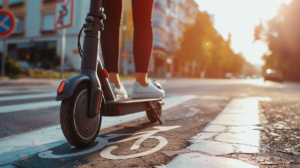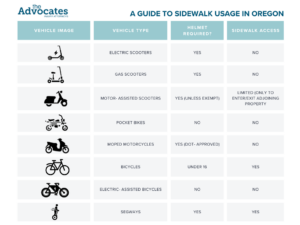
Oregon is home to countless outdoor-friendly cities that encourage scenic tourism, inviting residents and visitors alike to explore on foot or by bike, scooter, and other pedestrian-friendly vehicles. Navigating these areas safely isn’t just about enjoying the sights—knowing and following local regulations on these modes of transport is essential. This not only enhances the experience but also minimizes potential legal liabilities, ensuring that in the unlikely event of an accident, compliance with regulations reduces the chances of being held responsible.
Electric Scooters
A growing favorite in urban areas, electric scooters offer eco-friendly and agile travel, making it easy to zip around without emissions. Today, they’re readily available at official stops and street corners, with access as simple as scanning a QR code and completing a quick registration.
- Maximum Output: Limit of 1000 watts.
- Speed Restrictions: Though they can reach speeds up to 24 mph, the legal limit is capped at 15 mph on flat ground.
- Lighting Requirements: Approved lights are required when visibility is low.
- Age Limit: Riders must be at least 16 years old.
- Helmet and Lights: Both are required by law.
- Sidewalk and Crosswalk Use: Riding on sidewalks or crosswalks is strictly forbidden.
- Local Ordinances: Cities or counties may impose additional restrictions on usage.
Gas Scooters
Less common in city centers, gas scooters provide a compact yet powerful alternative for quick, short-distance travel.
- Engine Size: Must not exceed 35cc displacement.
- Regulatory Consistency: Follows the same requirements as electric scooters concerning age, helmet use, lighting, and sidewalk/crosswalk restrictions.
Motor-Assisted Scooters
Motor-assisted scooters have additional guidelines, including exceptions based on religious beliefs and specific sidewalk rules.
- Helmet Exception: A helmet is not required if it conflicts with religious beliefs.
- Sidewalk Access: May use sidewalks solely to access or exit adjoining properties.
- Pathway Restrictions: Local laws or park regulations may prohibit these scooters on bike lanes, pedestrian paths, or within state parks.
- Right of Way and Warnings: Riders must yield to pedestrians, giving an audible signal when overtaking.
- Crosswalk Protocol: Scooters should be walked, not ridden, through crosswalks, though this doesn’t apply to individuals with disabilities.
Pocket Bikes
These mini motorbikes sport a sleek, sporty look that appeals to enthusiasts, though their usage is usually limited to private areas.
- Private property only: Allowed only with the owner’s permission.
- No public roads: Illegal on highways or public premises.
- Violations: Use on public roads can lead to fines.
- Engine capacity: Exceeds 35cc; capable of speeds over 24 mph.
- Not road-compliant: Fails federal safety standards for motorcycles and mopeds.
- No passengers allowed.
Moped Motorcycles
A classic choice for urban and rural commuting, mopeds remain popular for their simplicity and economy, perfect for practical riders not seeking high speeds.
- Engine capacity: Must be between 35.01 and 50cc if combustion-powered.
- Speed limit: Cannot exceed 30 mph on level ground.
- Automatic operation: No need for clutching or shifting once in motion.
- Driver’s license required: License needed, but not a motorcycle endorsement.
- Registration and insurance: Required for operation on public roads.
- No passengers allowed.
- DOT-approved helmet: Mandatory.
- Bike lane access: Only when powered by pedals.
- Must be registered.
Bicycles
A reliable and accessible mode of transport, bicycles continue to be widely used for both recreation and daily commutes, supporting an active and sustainable lifestyle.
- Same rights and duties: Riders have the same rights and responsibilities as vehicle drivers on public roads, with few exceptions.
- Lighting requirement: Must use approved lights in low-visibility conditions.
- Helmet requirement: Mandatory for riders under 16.
Electric-Assisted Bicycles
Equipped with motor support, these bicycles are ideal for those looking to travel longer distances or tackle hills without giving up the pleasure of pedaling.
- Classification: Considered a bicycle, not a motor vehicle, under Oregon law.
- Pedal and motor requirements: Must have fully functional pedals and an electric motor with a maximum output of 1,000 watts.
- Speed limit: Capable of speeds up to 20 mph on flat ground.
- Lighting requirement: Must use approved lighting when visibility is limited.
- Minimum age: 16 years old.
Segways
Designed for personal mobility in urban settings, Segways offer a unique blend of technology and comfort, ideal for sightseeing or short city commutes. But don’t be fooled by their playful design and fun appeal—when riding, you’re still considered a driver under the law.
- Device type: Classified as an electric personal assistive mobility device.
- Operating areas: Allowed on bike lanes, paths, sidewalks, and roads with speed limits of 35 mph or less (unless restricted by local law).
- Speed limit: Maximum speed is 15 mph.
- Lighting requirement: Approved lighting required during low-visibility times.
- Crosswalk access: Permitted in bike lanes, sidewalks, and crosswalks.

DUI Liability
All the modes of transportation listed above—including electric and gas scooters, motor-assisted scooters, pocket bikes, mopeds, bicycles, electric-assisted bicycles, and Segways—are subject to DUI (Driving Under the Influence) laws. Operating any of these vehicles while impaired can result in legal charges, as they are considered modes of transportation on public roads or areas open to public access. Oregon law applies DUI regulations broadly, ensuring that impaired operation of any of these vehicles is prohibited.
Sidewalk Usage
When it comes to sidewalk usage, only bicycles and Segways are permitted to share the pathway with pedestrians. However, riders of both vehicles must remain vigilant, yielding the right of way to pedestrians and ensuring a smooth coexistence on these shared spaces.
Source: OREGON GOV
